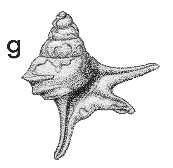
Revised descriptions of New Zealand Cenozoic Mollusca from Beu and Maxwell (1990)

 | Revised descriptions of New Zealand Cenozoic Mollusca from Beu and Maxwell (1990) | 
|
  (Pl. 6g): Hampden Beach, Bortonian (GNS; specimen figured by Marshall and Murdoch 1920, pl. 7, fig. 13) |
Beu & Maxwell (1990): Chapter 7; p. 104; pl. 6 g.
Synonymy: Dicroloma (sensu lato) zelandica Marshall 1919, p. 228; Beu & Maxwell 1990, p. 104, pl. 6 g; Maxwell 1992, p. 91, pl. 9h, i; Hemichenopus zelandicus Nielsen 2005, p. 1123, fig. 2.6-2.8
Classification: Aporrhaidae
Description: Size moderate for family (height c.30 mm), basically elongate-ovate but adults greatly modified in shape by apertural processes. Protoconch mamillate with apex somewhat flattened, of 4 smooth, strongly convex whorls. Teleoconch of 5-6 whorls, strongly and evenly convex at first, developing a weak median angulation on 5th whorl; last whorl increasing sharply in diameter, with sharply defined median and peribasal keels. Axial sculpture commencing as weak, almost straight, strongly prosocline threads, followed by strongly opisthocyrt costellae reaching from suture to suture on spire but stopping at peribasal angulation on last whorl of subadult shells, and becoming obsolete on last or penultimate whorl of adults. Spiral sculpture commencing as 7 or 8 fine, rounded cords with interstitial threads appearing during growth, one cord becoming stronger than others on 5th whorl at median angulation, and another relatively strong cord at peribasal angulation on subadult shells; base of last whorl with about 8 low cords with some interstitial threads, upper 4 or so stronger than others. Aperture moderately large, columella vertical, almost straight, probably very short in subadult shells, but produced anteriorly in adults to form a long, narrow, slightly curved siphonal canal. Inner lip with callus smear in young shells, moderately callused in adults; outer lip probably thin with a broad, deep arcuate sinus posteriorly in immature shells, but in adults considerably thickened and bearing 2 very prominent digitations corresponding to keels. Posterior digitation directed away from and slightly behind aperture, anterior digitation directed forwards; each of similar length to siphonal canal and bearing a shallow longitudinal groove along its inner face.
Comparison: Hemichenopus zelandicus is one of the most unusual and interesting of all New Zealand Eocene gastropods, for it has usually been assigned to Dicroloma, and all other known records of the genus are from the Mesozoic, particularly from the Jurassic. However, apart from its apertural characters, D. zelandica is not particularly like the type species, D. lorieri (Orbigny, 1847) (mid-Jurassic, France), which lacks definite axial sculpture, but has broadly V-shaped growth lines. Nielsen (2005, pp. 1123, 1124) pointed out that D. zelandica more nearly resembles Hemichenopus araucanus (Philippi, 1887) (Eocene?, Peninsula Arauco, Chile; type species of Hemichenopus Steinmann & Wilckens, 1908) than Mesozoic Dicroloma species, and assigned D. zelandica to Hemichenopus.
Distribution: Bortonian- Kaiatan; Bortonian, Hampden Beach (type); McCulloch's Bridge; Kapua Tuff, Waihao River. Not uncommon in the lower part of the Hampden Formation at Hampden Beach, but very difficult to collect; relatively common in the Kapua Tuff but no specimen known with a complete outer lip.
Cite this publication as: "A.G. Beu and J.I. Raine (2009). Revised
descriptions of New Zealand Cenozoic Mollusca from Beu and Maxwell (1990). GNS
Science miscellaneous series no. 27."
© GNS Science, 2009
ISBN
978-0-478-19705-1
ISSN 1177-2441
(Included with a PDF facsimile file
copy of New Zealand Geological Survey Paleontological Bulletin 58 in CD version
from: Publications Officer, GNS Science, P.O. Box 30368 Lower Hutt, New
Zealand)